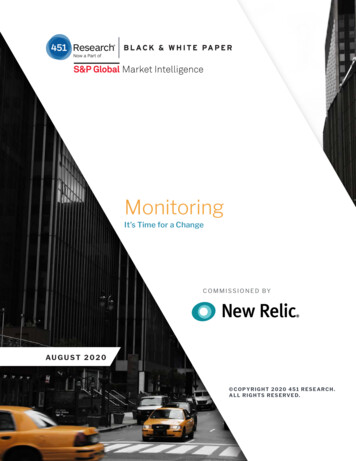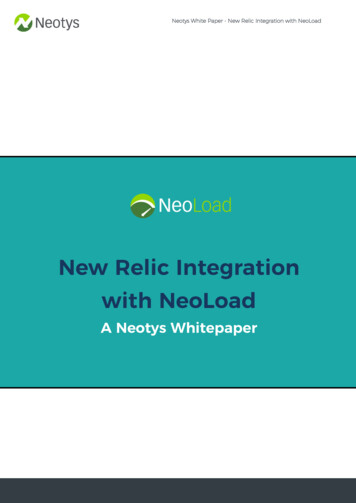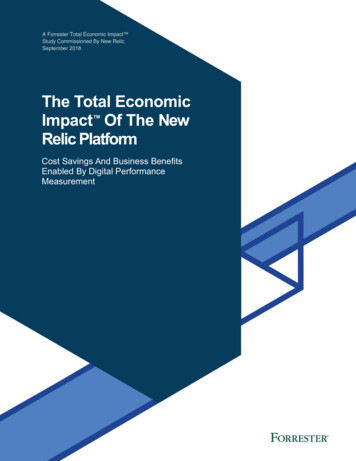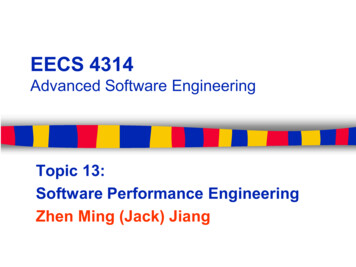
Transcription
MonitoringIt’s Time for a ChangeCOMMISSIONED BYAU G U S T 2 0 2 0 COPYRIGHT 2020 451 RESEARCH.A L L R I G H T S R E S E R V E D.
About this paperA Black & White paper is a study based on primary research surveydata that assesses the market dynamics of a key enterprise technologysegment through the lens of the “on the ground” experience and opinionsof real practitioners — what they are doing, and why they are doing it.A B O U T T H E AU T H O RNANCY GOHRINGS E N I O R A N A LY S T, A P P L I C AT I O N A N DINFRASTRUCTURE PERFORMANCENancy Gohring covers application and infrastructureperformance for 451 Research, including ITmonitoring, application performance managementand log management.Prior to joining 451 Research, Nancy was Editorin Chief of the enterprise IT publications at FierceMarkets. She launched the DevOps publication,setting the editorial direction for the new coveragearea, and oversaw seven publications aimed at seniorenterprise IT executives.COMMISSIONED BY NEW RELIC2
Executive SummaryThe application and IT infrastructure monitoring sector is experiencing a period of dramaticchange. In a recent study conducted by 451 Research and commissioned by New Relic, only 11%of the 700 decision-makers we surveyed said they were satisfied with their current monitoringplatforms. Eighty-three percent are either actively seeking new monitoring tools or have plans toexpand or improve their approach to monitoring.Figure 1: Enterprise satisfaction level with current monitoring productsSource: 451 Research custom surveyQ: Which of the following models best characterizes your company’s current monitoring status?Base: All respondents (n 700)44%My organization is actively seeking new, sustainable monitoring solutions for a scaling system,or is likely to be within the next year39%My organization already uses a series of monitoring solutions, but is working to instrument new services,and to share common monitoring practices/software across the organization11%My organization is presently satisfied with our current monitoring solutions without a perceived need for change5%In the present global tech landscape, my organization’s needs and priorities are emergent and changing;new monitoring solutions may or may not be a priority, depending on who you ask, and whenThe primary drivers behind this significant shift are application and infrastructure modernizationefforts that include the adoption of cloud and cloud-native technologies such as containers,Kubernetes and microservice architectures. While these technologies enable important businessimperatives – such as the ability to quickly build the kinds of capabilities customers demand– they create a significantly more complex and dynamic environment than the traditionalapplication stack. In turn, these dynamics create new demands on the tools used to identify andcorrect performance problems.B L A C K & W H I T E M O N I TO R I N G : I T ’ S T I M E F O R A C H A N G ECOMMISSIONED BY NEW RELIC3
Broadly speaking, the widespread discontent with existing monitoring tools is spurringthe evolution from monitoring to observability. We define observability as the tools andprocesses that make systems ‘observable’ so practitioners can readily discover performanceproblems and why they are occurring. Most organizations require new tools to supportobservability since traditional monitoring tools may not be able to collect the variety ofoperations data at the scale required or support the kind of flexible data exploration thatusers need in cloud-native environments.As organizations transition to observable systems, they are faced with a growing array oftools, both open source and commercial. While open source software has long been strongin monitoring, we are still seeing increased interest in open source. Our survey uncovered thedrivers behind the adoption of open source as well as the challenges related to using it. Wealso learned that there is remarkable overlap of open source and commercial tools; all butthree of the 700 open source monitoring tool users either currently use or are planning touse commercial monitoring tools. We think this widespread use of both commercial and opensource monitoring tools will drive demand for integrations that allow organizations to takeadvantage of the best of both worlds.Also notable among our findings is that organizations that employ traditional applicationand infrastructure technologies struggle with monitoring more than their counterparts thathave more readily embraced cloud-native technologies. Without strong monitoring practices,these organizations won’t achieve good visibility into performance, whether they haveadopted cloud-native technology or not. At risk is the business itself. Our research indicatesthat the bulk of end users will change the app or service they use due to poor performance,and such loss of customers can significantly undermine the business.B L A C K & W H I T E M O N I TO R I N G : I T ’ S T I M E F O R A C H A N G ECOMMISSIONED BY NEW RELIC4
Cloud-Native Adoption Increases OpenSource Monitoring RelevanceBusinesses are choosing open source monitoring tools for significant reasons. While cost hashistorically been a primary driver for open source deployments, in our survey it ranked fourthbehind customization, scalability and access to source code for auditability.Figure 2: Reasons for choosing open source softwareSource: 451 Research custom surveyQ: Which of the following factors influenced your decision to use open source monitoring tools?Base: All respondents (n 700)Ability to customize to meet our needs55%Scale: The ability to collect the volume of data that our environment requires48%Access to source code for auditability44%Lower overall cost42%The ability to monitor Kubernetes41%Existing expertise with the query language38%Internal requirement to use on-premises software36%Sunk investment in open source software33%Existing expertise with using the platform23%Potential for data loss22%Fear of vendor lock-InCulture20%4%We’re hearing more about Kubernetes serving as a driver of open source monitoring adoptionbecause of the close integration with Prometheus. Forty-one percent of respondents cited theability to monitor Kubernetes as a factor influencing their decision to use open source, a figurethat coincidentally matches the adoption rate of Kubernetes among the advanced respondentsto our Voice of the Enterprise DevOps survey.B L A C K & W H I T E M O N I TO R I N G : I T ’ S T I M E F O R A C H A N G ECOMMISSIONED BY NEW RELIC5
Figure 3: Kubernetes adoption rateSource: 451 Research’s Voice of the Enterprise: DevOps, Workloads and Key Projects 2020Q: What is your organization’s adoption status for Kubernetes?Base: All respondents (n 474)0.2%15%18%Full adoption across 100% of IT organizationSome adoption at team level, but not by all applicable IT teamsIn discovery/proof of concept8%Plan to trial in next 12 months27%5%Plan to trial in next 24 monthsConsidering but no current plan to implementNot in use/not in plan14%14%OtherHowever, users of open source monitoring tools face some struggles. We asked Prometheususers about common challenges and found that the majority of users struggle with an array ofproblems. For instance, 89% of the Prometheus users surveyed struggle with adding a back-enddatabase to handle the growing volume of data. Eighty-seven percent of respondents said thatthey found aggregating Prometheus metrics across clusters to be time-consuming and difficult,at least sometimes.B L A C K & W H I T E M O N I TO R I N G : I T ’ S T I M E F O R A C H A N G ECOMMISSIONED BY NEW RELIC6
Figure 4: Challenges faced by Prometheus usersSource: 451 Research custom surveyQ: Do you agree or disagree with the following challenges associated with the use of Prometheus at your company?Base: All respondents (n 187)Aggregating Prometheus metrics acrossclusters is time-consuming and difficult51%Adding a back-end database to handle growing volume ofmetrics takes too much time and management overhead36%47%42%Enabling search across Prometheusdeployments has proved problematic43%38%Using Grafana to view data collected byPrometheus is more difficult than we would like43%36%Grafana dashboard sprawl is a significant problem35%Not enough people know PromQL toget the most out of 20% 30% 40% 50% 60% 70% 80% 90% 100%Strongly Agree: High on our priority list. Constantly have to manage this risk. Something that is a constant struggleSomewhat Agree: Challenges us at times but not consistent. Sometimes a priority, sometimes notDisagreeNot ApplicableTraditional organizations struggle even more with these challenges than their counterparts thathave adopted cloud-native technologies. When asked about their technology and monitoringenvironments, 32% said they have a mix of cloud-native and traditional technologies and werelooking to make some improvements to their monitoring environments, followed by 21% whosaid they use traditional technologies.B L A C K & W H I T E M O N I TO R I N G : I T ’ S T I M E F O R A C H A N G ECOMMISSIONED BY NEW RELIC7
Figure 5: Application environment and approach to monitoringSource: 451 Research custom surveyQ: Which of the following best describes the application environment and approach to monitoring in your company?Base: All respondents (n 700)28%21%Traditional – We primarily use a traditional technology stack and don’thave significant efforts underway to modernize our applications or thetools/approaches we use to monitor this environmentMixed – We support a mix of cloud-native (i.e., microservices,containers or Kubernetes) and traditional applications and sufferfrom monitoring tool sprawl; we’re looking for ways to sharemonitoring tools and best practices across the companyCloud-Native Newbies – We are beginning to adopt cloud-nativetechnologies and require a new approach to monitoring in thisenvironment19%32%Cloud-Native – Our applications are primarily built usingcloud-native technologies and we have implemented moderntools and approaches to monitoring in this environmentWhen we looked at the problems faced by Prometheus users based on their level of adoption ofcloud-native technologies, we found that traditional organizations were more likely to strugglethan their cloud-native counterparts. Across the board, more traditional technology users citedissues – such as not having enough people who know the PromQL query language, challengeswith using Grafana for dashboarding, enabling search across Prometheus deployments andadding a back-end database – than their cloud-native counterparts.B L A C K & W H I T E M O N I TO R I N G : I T ’ S T I M E F O R A C H A N G ECOMMISSIONED BY NEW RELIC8
Figure 6: Traditional organizations have harder time across the board with PrometheusSource: 451 Research custom surveyQ: Which of the following best describes the application environment and approach to monitoring in your company?Q: Do you agree or disagree with the following challenges associated with the use of Prometheus at your company?AGREE ONLY (those who selected either somewhat agree or strongly agree)Base: All respondents (n 187)Cloud-Natives (N 42)Cloud-Native Newbies (N 43)Mixed (N 55)Traditional (N 47)83%84%Not enough people know PromQL toget the most out of Prometheus73%85%79%74%73%Using Grafana to view data collected byPrometheus is more difficult than we would like94%76%72%Grafana dashboard sprawl is a significant problem65%87%86%Enabling search across Prometheusdeployments has proved problematic74%71%94%86%81%91%96%Adding a back-end database to handle growing volume ofmetrics takes too much time and management overheadWe’re already seeing several market developments aimed at solving some of these pain points,as well as others that commonly frustrate users of open source monitoring software. Forinstance, startups are emerging with back-end databases targeted at easing some of the scalingchallenges experienced by some Prometheus users. We anticipate further developments here,particularly as adoption of open source monitoring tools grows and their challenges becomemore commonplace.B L A C K & W H I T E M O N I TO R I N G : I T ’ S T I M E F O R A C H A N G ECOMMISSIONED BY NEW RELIC9
Overlap of Commercial and OpenSource Monitoring ToolsOur survey exclusively targeted users of open source monitoring tools, and we were surprisedhow widely this segment of the market also uses commercial tools. More than three-quarters(80%) of the open source monitoring tool users we surveyed are currently also using commercialmonitoring tools in production, and a further 15% have commercial monitoring tools in pilots. Therest plan to begin using commercial monitoring tools within a year. Only three of the open sourcetool users said that they had no plans to use commercial monitoring tools.Figure 7: Use of commercial monitoring toolsSource: 451 Research custom surveyQ: Which of the following best characterizes your adoption of commercial monitoring tools at your company?Base: All respondents (n 700)0.1%1% 0.4%3%15%Currently deployed, in productionPiloting usage and may launch if successfulPlan to use over the next 6 monthsPlan to use over the next 7 to 12 monthsPlan to use after the next 12 monthsNo plans to use80%Given the broad market demand to unify operations data and tools, we anticipate that this overlapof commercial and open source tools will generate interest in deep integrations across thetools. We’re already seeing that happen, particularly with Prometheus where users want to shipoperations data about Kubernetes deployment collected by Prometheus into a commercial toolwhere it can be combined with operations data already being collected about other infrastructure.B L A C K & W H I T E M O N I TO R I N G : I T ’ S T I M E F O R A C H A N G ECOMMISSIONED BY NEW RELIC10
Our survey also discovered that users of open source monitoring tools who also use commercialtools tend to outweigh the positives of their commercial tools over the negative. When we askedhow they’d characterize their commercial tools, ‘easy to use,’ ‘well-supported’ and ‘scalable’topped the list. Respondents cited fewer characterizations with negative connotations such as‘limited capabilities,’ ‘expensive’ and ‘lacking support to monitor required technologies.’ However,here too organizations employing traditional technologies struggled more than those usingcloud-native software. Cloud-native users appear more satisfied; they are more likely than thetraditional organizations to name the positive characteristics.Figure 8: Satisfaction with commercial monitoring tools: cloud-native vs. traditional businessesSource: 451 Research custom surveyQ: Which of the following best describes the application environment and approach to monitoring in your company?Q: Which of the following would you use to describe the commercial products currently in use at your company?Base: All respondents (n 561)Cloud-Native (n 169)Cloud-Native newbies (n 106)Mixed (n 173)Traditional (n 113)Scalable to our data volume needs43%48%47%43%Well-supported when we need help40%Easy to use42%Lacking support to monitor the technologies we useLacking the integrations we need with the tools we 34%21%18%21%39%21%Expensive55%37%28%26%Limited in capabilities52%32%32%39%B L A C K & W H I T E M O N I TO R I N G : I T ’ S T I M E F O R A C H A N G ECOMMISSIONED BY NEW RELIC11
Conclusions and RecommendationsBroadly speaking, our survey indicates that businesses must embrace modern technologiesand tools, and in doing so execute a transition to observability from traditional monitoring.Organizations looking to modernize their approach to monitoring should consider ensuringseveral capabilities: tool integration, scale and advanced analytics across different data types.Tool IntegrationA common reaction for many businesses that are struggling with getting good visibility intothe performance of their application and infrastructure environments is to add new tools. Oursurvey bears this out, indicating that a majority of users either have already deployed or plan toimplement 12 different types of commonly used monitoring and incident response functions. Thepercentage of respondents who have no plans to deploy the tools was remarkably small: networkmonitoring and database monitoring each registered zero respondents with no plans to deploy,and log management and infrastructure monitoring had 1% each with no plans to deploy.Figure 9: Monitoring tool adoptionSource: 451 Research custom surveyQ: Which of the following best characterizes your adoption of the following monitoring tools at your company?Base: All respondents (n 700)Currently deployed, in productionPiloting usage and may launch if successfulPlan to use over the next 6 monthsPlan to use over the next 7 to 12 monthsPlan to use after the next 12 monthsNo plans to useTicketingAlerting and on-call management36%39%Network monitoring60%Database monitoring62%Mobile applicationperformance managementSynthetic monitoring47%36%Real-user monitoringDistributed tracingApplication performancemanagement (APM)Event analyticsInfrastructure monitoringLog management/analytics51%39%52%46%58%62%2%5%3% 1%3%3% 1%0.4%8%28%3% 1%0.3%9%25%3%3%3%11%34%3% 2%7%17%36%2% 1%2%4%12%29%2%4% 6%14%35%3%2%11%32%1% 1%3%16%31%3% 0.1%1%6%32%2%1%9%27%1% 0.1%35%44%15%15%B L A C K & W H I T E M O N I TO R I N G : I T ’ S T I M E F O R A C H A N G ECOMMISSIONED BY NEW RELIC12
These results do not indicate that respondents necessarily plan to use a different tool from adifferent vendor for each function, and we would recommend that organizations consider usingtools that offer multiple functions to avoid challenges associated with tool sprawl. It has becomeincreasingly possible to do so, with many vendors expanding horizontally over the past few yearsto deliver several types of tools. In fact, among the top 10 vendors by revenue in this sector, allhave offerings in six or more of the categories we track, with two delivering in eight categories,according to our research.Whether an organization buys some or all of its required functions from a single vendor, usersmust be able to correlate and analyze data collected across the various tools and functions. Forinstance, by correlating data from real-user monitoring, APM and logging tools, users can morerapidly identify the source of performance problems and solve them.ScaleCloud-native application and infrastructure environments generate a much larger volumeof operations data than traditional stacks, and legacy tools may not be able to keep up.Observability requires users to collect a potentially large and varied dataset that can ultimatelyhelp DevOps or operations professionals pinpoint the cause of performance problems. Toolsmust have the capability to handle this large volume of data efficiently and affordably.Advanced Analytics Across Different Data TypesAn observability practice must offer advanced analytics capabilities so that users can easily andflexibly slice and dice data in meaningful ways. In addition, advanced technologies like machinelearning can be helpful in automatically surfacing insights such as anomalies, allowing users tomore quickly learn about performance problems and their sources. Modern tools are applyingmachine learning in new ways that aim to solve a host of challenges facing organizations thathave embraced cloud-native technologies. The potential is strongest in tools that can applymachine learning and other analytics across a variety of data types, potentially including metrics,distributed traces, logs and events.Ultimately, the path to observability will likely entail the adoption of a new mix of tools thatincludes integrated commercial and open source software and services, as well as a modern ITapproach to development that allows migration from legacy technologies that no longer supportimportant business goals.B L A C K & W H I T E M O N I TO R I N G : I T ’ S T I M E F O R A C H A N G ECOMMISSIONED BY NEW RELIC13
DemographicsFor our survey, we reached out to 700 IT professionals in the US and Europe, primarily frommidsize companies. Well over three-quarters (86%) directly make decisions related to thepurchasing of monitoring tools at their company, and 14% influence such decisions. All theorganizations currently use open source management tools.Figure 10: GeographySource: 451 Research custom surveyQ: In which country are you located?Base: All respondents (n 700)14%United States14%50%UKFranceGermany22%Figure 11: Company sizeSource: 451 Research custom surveyQ: What is the total number of employees in your company?Base: All respondents (n 00 34%B L A C K & W H I T E M O N I TO R I N G : I T ’ S T I M E F O R A C H A N G ECOMMISSIONED BY NEW RELIC14
Figure 12: IndustrySource: 451 Research custom surveyQ: Which of the following best describes your company’s industry?Base: All respondents (n 700)Technology/Professional/Business and Managed Services17%Finance (Banking, Securities, etc.)11%Retail10%High ucation (K-12/College/University)4%Transportation and Logistics4%Energy/Oil & Gas4%Insurance3%Discrete Manufacturing3%Utilities2%Government (Local/State/Federal)2%Process Manufacturing1%Consumer Packaged Goods1%Life Sciences (Biotech, Pharmaceuticals, etc.)1%Consumer and Recreational Services1%Wholesale1%Securities and Investment Services1%Communications, Publishing and Media1%Other (please specify)1%Warehousing0.3%B L A C K & W H I T E M O N I TO R I N G : I T ’ S T I M E F O R A C H A N G ECOMMISSIONED BY NEW RELIC15
About 451 Research451 Research is a leading information technology research and advisory company focusing on technology innovation and market disruption. More than 100 analysts and consultants provide essential insight to more than 1,000 client organizations globally through a combination of syndicated research and data, advisoryand go-to-market services, and live events. Founded in 2000, 451 Research is apart of S&P Global Market Intelligence. 2020 S&P Global Market Intelligence. All Rights Reserved. Reproduction and distribution of thispublication, in whole or in part, in any form without prior written permission from S&P Global MarketIntelligence is forbidden. The terms of use regarding distribution, both internally and externally, shallbe governed by the terms laid out in your Service Agreement with 451 Research and/or its Affiliates. The information contained herein has been obtained from sources believed to be reliable. 451Research and S&P Global Market Intelligence disclaim all warranties as to the accuracy, completeness or adequacy of such information. Although 451 Research may discuss legal issues related tothe information technology business, 451 Research does not provide legal advice or services andtheir research should not be construed or used as such.The content of this artifact is for educational purposes only. S&P Global Market Intelligence doesnot endorse any companies, technologies, products, services, or solutions. S&P Global MarketIntelligence shall have no liability for errors, omissions or inadequacies in the information containedherein or for interpretations thereof. The reader assumes sole re-sponsibility for the selectionof these materials to achieve its intended results. The opinions expressed herein are subject tochange without notice.N E W YO R K55 Water StreetNew York, NY 10041 1 212 505 3030SAN FRANCISCOOne California Street, 31st FloorSan Francisco, CA 94111 1 212 505 3030LO N D O N20 Canada SquareCanary WharfLondon E14 5LH, UK 44 (0) 203 929 5700B O S TO N75-101 Federal StreetBoston, MA 02110 1 617 598 7200
change. In a recent study conducted by 451 Research and commissioned by New Relic, only 11% . of the 700 decision-makers we surveyed said they were satisfied with their current monitoring platforms. Eighty-three percent are either actively seeking new monitoring tools or have plans to expand or improve their approach to monitoring.










